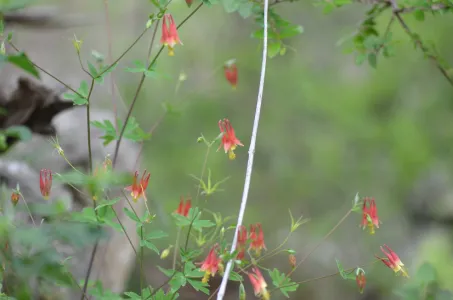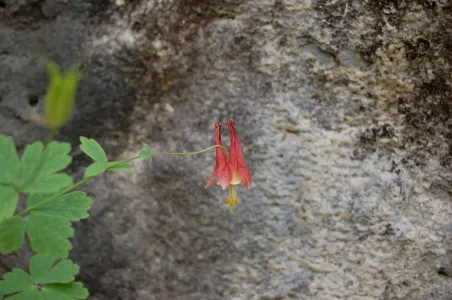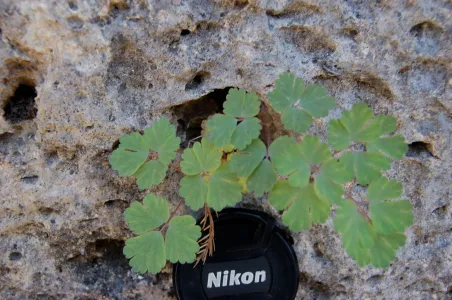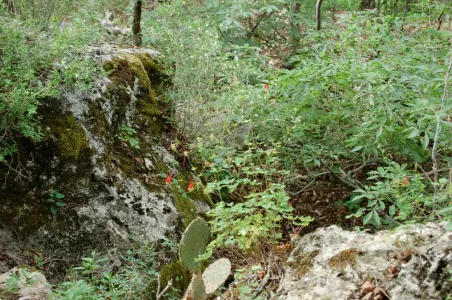By Emily Weiner and Delmar Cain
It really doesn’t take much to lift my spirits. As a matter of fact it took exactly 1 1/2 inches of rain. They may be smaller than usual but I think that we are going to have spring wildflowers. The Boerne Chapter of NPSOT (Native Plant Society of Texas) has selected one of those spring wildflowers now blooming as the NICE (Natives Instead of Common Exotics) Plant of the Month for April. The Eastern red columbine or wild red columbine (Aquilegia Canadensis) just adds to my enjoyment of the rain.
Our Boerne Chapter president-elect, Emily Weiner, added just the right touch to her description of the NICE choice in the NPSOT Newsletter. Since I could not improve upon her account, and with her permission, I tender it to you for your enjoyment.

Dark and gloomy spots in the garden gotcha down? Brighten them up with Eastern red columbine. This native perennial flourishes in the shade and provides interesting color and texture year-round. A member of the Ranunculaceae, or Buttercup family, red columbine can be found throughout the eastern United States and Canada. The columbine growing along wooded canyons and shady cliff faces of the Edwards Plateau are considered a distinct population. What can we say? Columbine loves our calcareous soils!
The red and yellow lantern-like flowers rise 1′ – 2′ feet high above the semi-evergreen mound of compound, deeply cleft leaves. As you might expect, the striking flowers are a favored nectar source for hummingbirds, bees, butterflies, and moths, and birds enjoy the tan seeds. Additionally, the Columbine Duskywing butterfly uses the red columbine as a larval host.

Red columbine is a true shade lover, doing best in partly to fully shaded areas. Plants exposed to continuous sun will likely exhibit stunted growth and suffer leaf burn. It is also important to ensure the soil is not too rich and is very well-drained.
The bloom period of the red columbine runs from February to July. Personally, I have seen red columbine blooming along the shaded rock faces at Guadalupe River State Park beginning in mid- March. The leaves will remain long after the bloom period has subsided; however, leaves may go dormant during extended periods of severe heat or drought.
Red columbine will happily self-sow and shamelessly hybridize with our native yellow columbines, producing a mixture of red and yellow flowers.

OPERATION NICE! TIP: Consider planting Columbine in those difficult shady areas instead of invasive exotics such as English ivy and vinca or water-loving geraniums and begonias.
Wild red columbine is not rare, but its presence in our area is something of a puzzler. In his book, Wildflowers of the Texas Hill Country, Marshall Enquist notes that this species seems “to be distributed along an arc from Bell County to Real County, paralleling the southern and eastern edge of the Hill Country.”
The USDA distribution map also indicates that it is found in just those eight Texas counties. And although found in all of the states north and east of us (except Louisiana) all the way into Canada, the closest native population to Bell County is in a few counties in the northeastern corner of Oklahoma and the northwestern corner of Arkansas.

I can just hear what my dad would say; “It’s a fur piece from Temple, Texas to Hot Springs, Arkansas or to Tulsa, Oklahoma.” And in between one would think that there is sufficient habitat for the wild red columbine, which the USDA lists as “dry woods to mesic or even low woods, especially along borders or clearings in oak-hickory, oak-maple, maple-basswood forests, black-oak savannas, cedar glades, pine woods and mixed conifer-hardwood forests.”
But “it can also be found on wooded to open rocky hillsides, bluffs calcareous cliffs, outcrops, ledges” and banks as it is in our area. Emily said it just right when she said it just “loves our calcareous soils.” However Bill Carr, formerly a botanist with the Nature Conservancy and later with the TPWD, was probably more accurate in noting that our population is a holdover from some ancient time when the climate and conditions were conducive to an even greater and more homogenous distribution of the species.
As for me, I like to think that we have a bit of our own version of the Lost Pines of Bastrop right here in Kendall County — the Stranded Wild Red Columbines of the Hill Country. They were probably were on their way to visit their relative, the Hinckley’s golden columbine, which resides only in Presidio County, and fell in love with the Hill Country.


